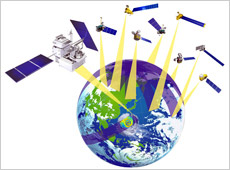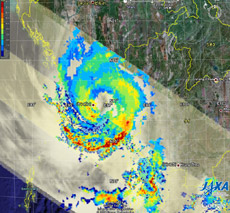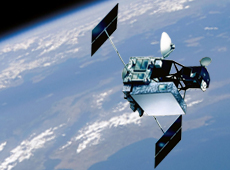
GPM, the Global Precipitation Measurement, is the mission to conduct frequent and accurate measurements of global precipitation (rain, snow and ice). GPM has the most advanced measurement technology available, carried on a core satellite, and a series of constellation satellites. The core satellite is scheduled for launch by H-IIA rocket in 2013 from the Tanegashima Space Center.

GPM - Global Precipitation Measurement
Global warming is the critical problem that is expected to have a great impact on the planet's water cycle, including the increase of the heavy rains and droughts. By monitoring the global precipitation in detail, GPM will help us learn about variations in the water cycle induced by the global warming. It will also contribute to our understanding of the extreme events of the weather and the climate. To predict global warming effects, a numerical climate model is used for supercomputer-based simulations. Precipitation measurement data in global scale is very important for improvement of the climate model, thus contributes to the climate change prediction accuracy.
Earth is known as the Water Planet. However, most water on Earth is seawater. Fresh water, sourced from rain and snow, is the precious and absolutely necessary resource for drinking and other human activities such as agriculture. Precipitation measurement will be beneficial for water resource management, including river management and controlling the storage capacity of dams.

A cyclone captured by TRMM
GPM's precursor is the Tropical Rainfall Measuring Mission satellite (TRMM), launched in 1997. It was the joint mission with the United States for measuring tropical and subtropical rainfall, which makes up almost two thirds of global precipitation. It has been more than ten years since its launch, yet the TRMM satellite is still in service. For TRMM, Japan developed the world's first space-born precipitation radar, and succeeded in three-dimensional measurements of precipitation distribution. The great success of the TRMM, ackowledged by the user community all over the world, has become the driver to promote GPM. Scientists and researchers are eagerly awaiting the best precipitation data ever, to be delivered by GPM, which is an upgraded version of the TRMM.
Energy is released when rain falls, thus heating the atmosphere. This is thought to be the energy source of global atmospheric circulation. TRMM was originally planed to understand the mechanism of this circulation. However, its unexpectedly long service has made it possible for us to conduct a wider range of science, and also the practical applications such as the weather and flood forecasting.
Based on the TRMM's achievements, we try to maximize GPM's contribution for society. For example, more accurate weather forecasting and typhoon prediction are made possible by measurements of global precipitation every three hours. Also, by monitoring precipitation in the river basins, flood warnings will be possible. It is said that about sixty percent of natural disasters are caused by heavy rain and flood. GPM data will be very useful not only in Japan but also in other Asian countries for reducing the risk and the losses caused by the typhoons and the floods.

Core satellite of the GPM mission
The core satellite will be equipped with the Dual-frequency Precipitation Radar (DPR) and the GPM microwave radiometer (GMI). DPR consists of a Ku-band radar and a Ka-band radar, which observe precipitation in three-dimension.
- The Ka-band radar has much greater sensitivity than the TRMM precipitation radar, and will be useful for observing light rain and snow.
- The Ku-band radar excels in measuring heavy rain in tropical and sub-tropical regions.
Using these two radars, all types of precipitation will be measured. Moreover, the simultaneous observation of the two radars allows measurement of rain drop size distribution, which will improve precipitation estimation accuracy.
However, rain is the phenomena which changes in a very short period of time. If the core spacecraft only, sampling error remains due to the scarce observation frequency. Multiple constellation satellites carrying microwave radiometers will enable the sufficient observation frequency. At the moment, we are expecting six to eight constellation satellites.
Microwave radiometers will estimate precipitation based on measurements of microwaves emitted and scattered by raindrops and ice particles (microwaves are radio waves with short wavelengths). For precipitation measurement, they are not as accurate as the DPR , because they are affected by the microwaves emission and scattering from the various materials on the ground and in the atmosphere other than the raindrops.
DPR is capable of direct observation of rain: it emits the radio wave pulse signal, and measure the echo reflected back from raindrops. Moreover, DPR data enables to calibrate and enhance the precipitation measurement of the microwave radiometers. Thus, combining the core satellite and the constellation satellites data, GPM will enable frequent and accurate global precipitation measurement. This is the key concept of GPM.
GPM is an international cooperative effort. JAXA and NASA are responsible for the core satellite, and JAXA is developing the most important instrument, DPR (the Dual-frequency Precipitation Radar), with the cooperation of the National Institute of Information and Communications Technology (NICT). DPR is now in the process of detailed design, and in manufacturing and testing of the engineering model to verify its design.
As for the constellation satellites, data is to be provided by partners around the world, such as NASA, the National Oceanic and Atmospheric Administration (NOAA); the European Organization for the Exploitation of Meteorological Satellites (EUMETSAT); the French space agency (CNES); the Indian Space Research Organization (ISRO); and the Brazilian Space Agency. Collaboration with the "Global Change Observation Mission - Water satellite (GCOM-W)", which is developed and scheduled for launch by JAXA in 2011, is also planned. Japan and the U.S. will play the primary role in instruments validation and ground data processing also, while continuing collaboration with other partners.
As for the constellation satellites, data is to be provided by partners around the world, such as NASA, the National Oceanic and Atmospheric Administration (NOAA); the European Organization for the Exploitation of Meteorological Satellites (EUMETSAT); the French space agency (CNES); the Indian Space Research Organization (ISRO); and the Brazilian Space Agency. Collaboration with the "Global Change Observation Mission - Water satellite (GCOM-W)", which is developed and scheduled for launch by JAXA in 2011, is also planned. Japan and the U.S. will play the primary role in instruments validation and ground data processing also, while continuing collaboration with other partners.

TRMM - Tropical Rainfall Measuring Mission
Japan earned international respect for the great success of TRMM and its technology for monitoring the water cycle. The world now has great expectations for GPM. For example, at the 3rd World Water Forum in Kyoto in 2003, early implementation of GPM was requested. In the GEOSS Ten-Year Implementation Plan (endorsed by the 3rd Earth Observation Summit, held in Brussels in 2005) better understanding of the water cycle was listed as one of the nine targeted social benefit areas where Earth observation can contribute, with GPM highlighted as the very important mission. The international focus on solving Earth's environmental problems absolutely inspires us to make GPM successful.
TRMM might be able to extend its mission until the GPM core satellite is launched in 2013. If so, while the GPM satellite is expected to perform measurements for more than five years, there is a chance that we will have accumulated radar precipitation data for over twenty years in total. Such accurate and comprehensive long-term dataset will promise to enhance the science on climate change and the water cycle. With the experience and knowledge gained through the TRMM mission, I will do my best for the success of the GPM mission, enhancing Japan's leadership in this area.
Masahiro Kojima
GPM/DPR Project Manager, Space Applications Mission directorate, JAXA
Mr. Kojima received his master's degree from the Graduate School of Engineering at Kyoto University in 1980, and joined the National Space Development Agency (now part of JAXA), where he developed satellite ground systems and data processing systems for Earth observation satellites. After developing precipitation radar for the Tropical Rainfall Measuring Mission, he joined the Global Precipitation Measurement / Dual-frequency Precipitation Radar (GPM/DPR) project. He has been in his current position since October 2003.
GPM/DPR Project Manager, Space Applications Mission directorate, JAXA
Mr. Kojima received his master's degree from the Graduate School of Engineering at Kyoto University in 1980, and joined the National Space Development Agency (now part of JAXA), where he developed satellite ground systems and data processing systems for Earth observation satellites. After developing precipitation radar for the Tropical Rainfall Measuring Mission, he joined the Global Precipitation Measurement / Dual-frequency Precipitation Radar (GPM/DPR) project. He has been in his current position since October 2003.
To Protect the Environment for a Peaceful Life
Measuring Greenhouse Gases from Space
Understanding the Global Water Cycle
Long-term Environmental Change: Observations of Earth
Three-Dimensional Observation of Clouds and Aerosols
Water, Air, and Waste Recycling
Measuring Greenhouse Gases from Space
Understanding the Global Water Cycle
Long-term Environmental Change: Observations of Earth
Three-Dimensional Observation of Clouds and Aerosols
Water, Air, and Waste Recycling